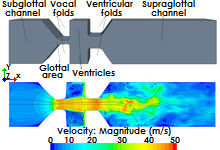HPC User Report from H. Sadeghi (Phoniatrics and Pediatric Audiology)
Numerical study of laryngeal aerodynamics
Computational fluid dynamics (CFD) is used to simulate the laryngeal aerodynamics during the complicated process of human voice production. The aim of the study is to evaluate the clinical applicability of CFD tools to analyze the phonation process.
Motivation and problem definition
Human phonation process is a result of fluid-structure interaction between laryngeal airflow and the two elastic vocal folds. Owing to the restricted accessibility of the human larynx, experimental investigation of this process is difficult. Therefore, the clinical diagnostics are almost totally restricted to the visual inspection of the vocal fold motion and the acoustic voice signal. The basic purpose of our studies is to investigate the potentials of CFD models in the clinical applications. In addition, different aspects of this process such as various patterns of vocal fold motion and the effect of passive ventricular folds as the second constriction of the larynx are reproduced to analyze the aero-acoustic sound generation.
Methods and codes

The unsteady incompressible Navier-Stokes equations are the governing equations of flow motion in the larynx. Large eddy simulations were performed using the finite volume method fully integrated in the commercial software package STAR-CCM+ (Siemens). A simplified three dimensional larynx model with externally imposed oscillations of vocal folds based on an experimental synthetic larynx model is employed. Despite the simplification of the model, the complicated aerodynamics of phonation and consequently the high mesh resolution required in the larynx (between 1.58 and 2.39 million cells) make the use of high performance computing (HPC) systems inevitable. Therefore, five computer nodes of RRZE’s Emmy cluster are used to perform the simulations in this study.
Results
Although none of the models simulated in our study, included a coupled fluid-structure interaction process, all of them reproduced characteristic features of laryngeal aerodynamics. These features include the glottal jet deflection in the cases without ventricular folds, intraglottal flow separation in the cases with convergent-divergent mucosal wave motion, fully three dimensional flow effects (such as the axis-switching effect) and finally straightening and elongation of the jet and increasing efficiency of phonation by inclusion of the ventricular folds.
It is worth mentioning that even with the mentioned use of HPC resources, the wall time of the simulations ranged up to more than 200 hours for 10 cycles of vocal fold oscillation. Therefore, these models are not applicable in daily clinical routine at the moment, although they are very valuable in basic voice science. The reduction of computational time for these models is one of the goals in our studies.
Outreach
- H. Sadeghi, S. Kniesburges, M. Kaltenbacher, A. Schützenberger, and M. Döllinger: Computational models of laryngeal aerodynamics: Potentials and numerical costs, Journal of Voice (Article in press).
- The project is running since October 2015. Since February 2018, the study is supported by DFG (DO1247/10-1) and FWF (Prof. Kaltenbacher; TU-Wien) within a joint research project.
Researcher’s Bio and Affiliation
Hossein Sadeghi obtained his Master degree in Computational Engineering at the Friedrich-Alexander University Erlangen-Nürnberg (FAU) and is currently a PhD student and scientific assistant under the supervision of Dr.-Ing. Stefan Kniesburges and Prof. Dr.-Ing Michael Döllinger (Head of research) at the division of Phoniatrics and Pediatric Audiology at the Department of Otorhinolaryngology, Head and Neck Surgery of University Hospital Erlangen and Medical Faculty of FAU.
